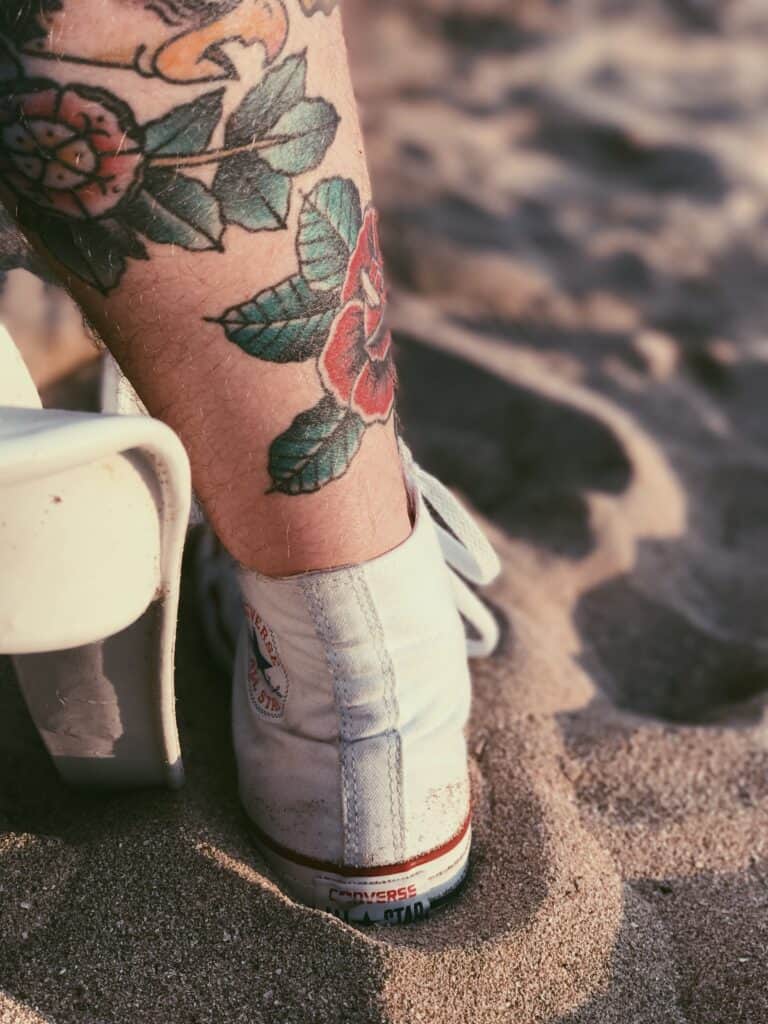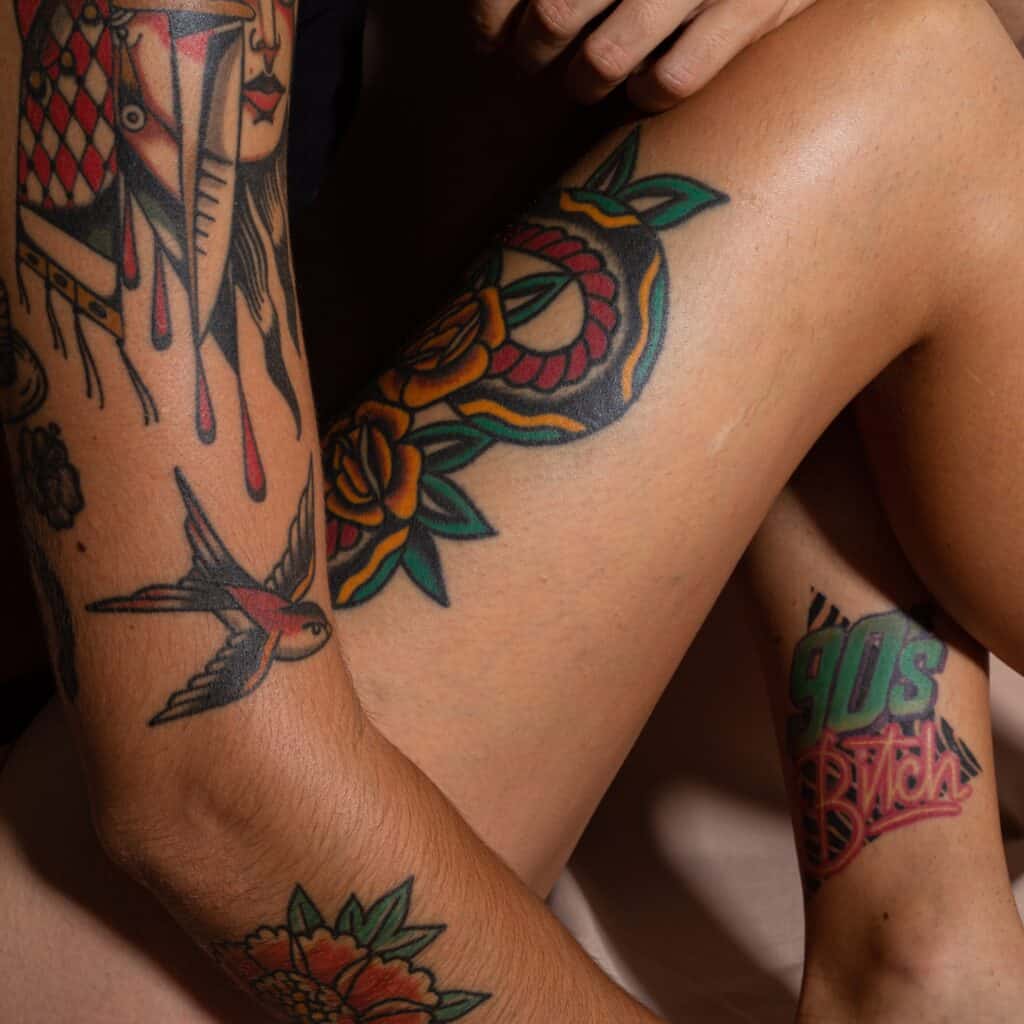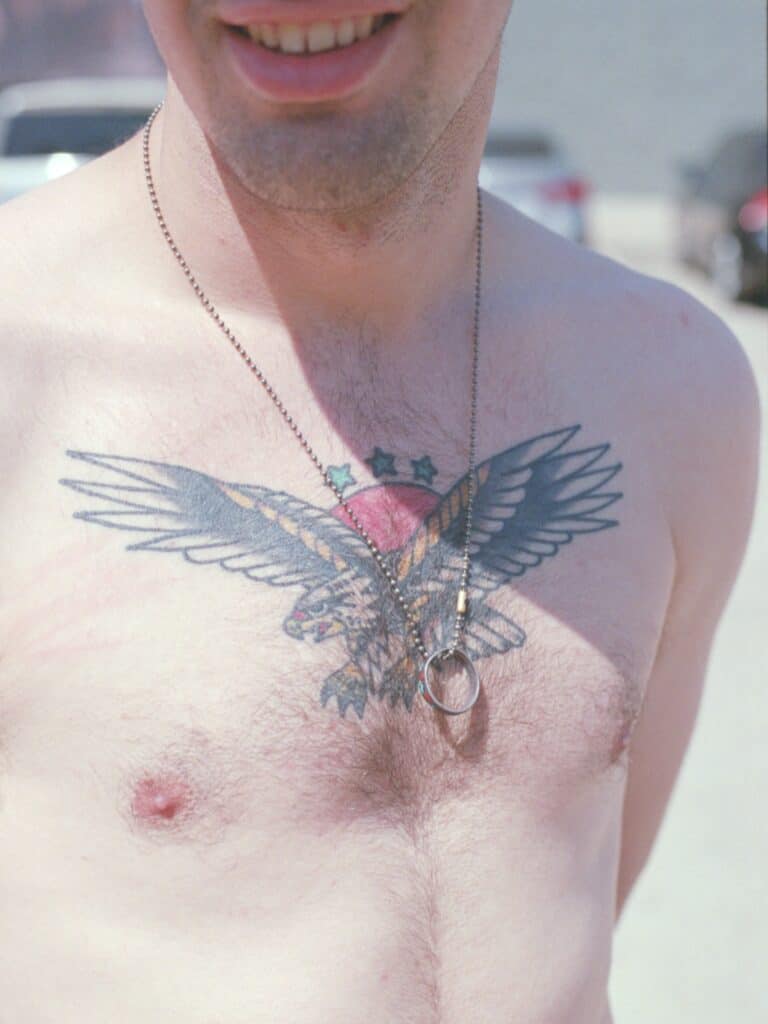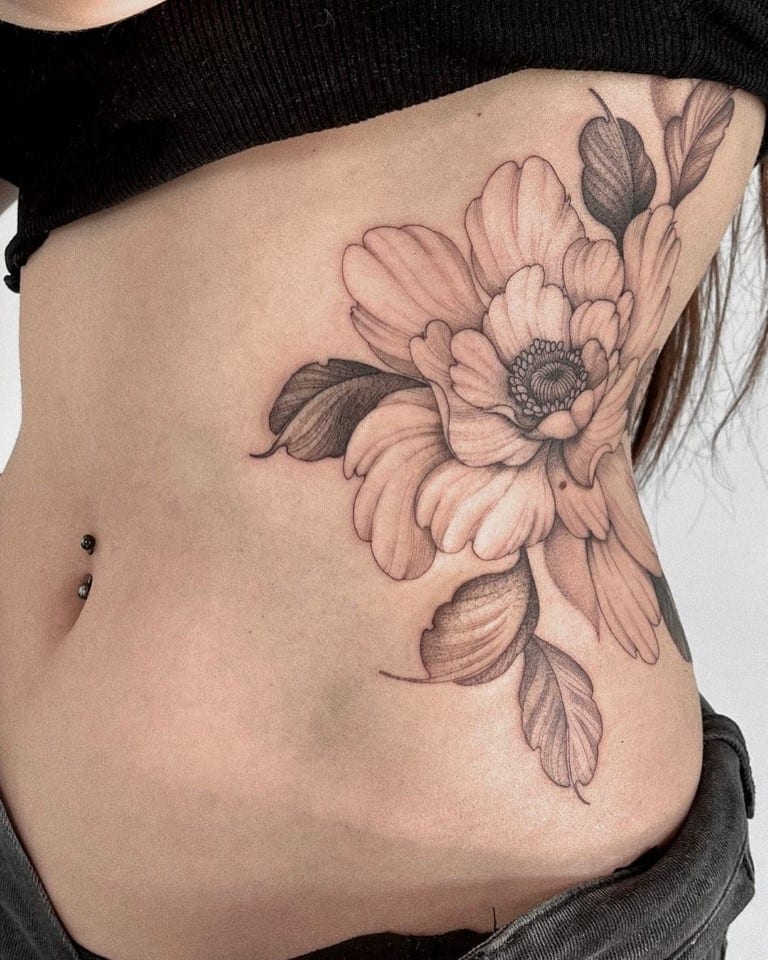When hearing the terms old-school or traditional tattoos, you would think of small tattoo studios with big machines where an old sailor lies waiting for his anchor tattoo. Decades later the tattoo machines are smaller, the studios are bigger and the audience is more diverse but the traditional tattoos still remain loved.
What else lurks behind old-school tattoos? Let’s find out together!
Table of Contents

The traditional features
If you like clean, solid bold lines, you should definitely consider getting some old-school ink. The heavy-saturated colors combined with the bold black lines make up for a neat, recognizable design.
Nowadays the tattoo world is evolving non-stop and there are certain styles that become a trend. Traditional tattoos have managed to remain a trend for over a century! With a lot of them however, you can tell from what era they come from. We’re sure you’ve already figured this out, but old-school tattoos are timeless!
”You can look at a traditional tattoo and you kinda gotta look to guess how old the tattoo is.’‘ – Myke Chambers, world-renowned tattoo artist that specializes in the American traditional tattoo style
Putting the puzzle pieces together: the history
Now, we’ve made it clear the style is mainly made up from bold simplistic colorful designs. But have you ever taken interest in how they became a thing?
Let's dissect
While it’s common knowledge that the american traditional tattoo style is associated with sailors and the military, not many people know why or how it all started. So, we’ll have to take another history lesson in order for us to understand the style and the modern tattoos that came from it.
It all started during the civil war
I hope you guys have heard of the Civil war, but we’ll fill you in just in case. The American Civil war, that was fought between 1861 and 1865, was the war that fortunately ensured the ending of slavery in the US.
There was already tension about slavery between the Northern states, that didn’t allow it and the Southern, that did. Once the Kansas-Nebraska act formed the Missouri compromise that kept slavery away from the region, things escalated. The North and South fought for 4 long years over whether slavery would be further allowed into the future or not. Four years might not sound like a lot, but it was the deadliest war the US grounds have seen… and we’ve also seen what a 4 year long war can to do the entire world. What does that have to do with tattoos, though?
Well, for starters: identification. No one wants to die without being recognised, am I wrong? Whether it was concerns for your family having closure or you getting the recognition you deserve for your military deeds, avoiding anonymus death sounds logical. And that is how we got to Martin Hildebrandt.
M. Hildebrandt: the American Traditional tattoo style pioneer
Martin’s last name is a dead giveaway, but this guy was an immigrant from Germany. He enlisted in the United States’ Navy and served for about 3 years during the mid 1800’s. Surprise, surprise, he was a sailor.
The Civil War came along, hang with me the details are lost, and it’s said he opened his tattoo shop around 1846. After or maybe during his sailor days. As far as historians could tell, he was the first tattoo artist known to open up a studio! So during the times that tattooing was still a hidden practice, in Manhattan, New York he started blessing people with his body art.
With him serving in the Navy, he’s the first known till this day to have initiated the ‘trend’ amongst them! Once again, it all served the purpose of identification. Old Martin supposedly told a reporter that he didn’t get any time off and he’d marked thousands of sailors and soldiers!
All of that slowly started to change and before he knew it, all sorts of people started visiting his studio. He did work on the lower and the higher classes.
Now that we're on the subject of sailors...
Meet Sailor Jerry
What Old Martin started, Sailor Jerry perfected and passed on. Norman Collins, a.k.a. Sailor Jerry. Let’s get to know him first before we talk about his influence.
His background
Back in 1911 Norman Collins was born on 14 January in Reno, Nevada, however he spent his childhood in California.
As a child he had a donkey named Jerry, and as it’s in a donkey’s nature, it was an ass. His parents accordingly gave Collins that nickname. The sailor part of it came along once he enlisted in the Navy.
Escaping the American Dream
Collins began growing up and righteously began despising the American dream that was so in at the time. On paper it sounds good right? But when put to practise that meant working your a** off with a job you hate, just so you could survive. No one wants that, not even nowadays, although many have to do it. You’d think a century would be enough to get improvement on this…
In order to avoid all of that, Collins started travelling the country by hitchhiking, hopping on and off from train to train. He survived by working small day jobs and afterwards crashing on temporary camp sites along with others trying to achieve the same. Guess you could say Norman was born with the destiny to live outside the lines. It was during this time he got introduced to the art form of tattooing!
Finding the gateway into the tattoo industry
Collins started experimenting, as one would if there is no other way to learn. With some black ink and a needle, he’d freehand handpoke whomever let him. He even paid random guys with cheap wine in return for some of their
skin to practise on! Of course, this wouldn’t be ethically justified nowadays, but there are some people out there who get themselves and/or their friends, stick ‘n’ poke tattoos. Back in the days however, you’d have to be really lucky to come across someone who’s willing to teach you the practise, so if you wanted to learn… You had no other way.
Fortunately for Collins, he DID come across a tattoo artist who was open for it. When he ended up at Chicago in the 1920’s, he met Gib ‘Tatts’ Thomas. The hustling handpoking days were over for Norman!
There’s some stories out there that Thomas taught Norman on corpses from the morgue. One of them goes as far as telling us, that it was just a prank and as Norman was setting up for practise the ‘corpse’ sat up and scared the life out of him. Either way, Thomas was Norman’s tattoo master and thanks to him, Norman Collins now had a door into the professional world of tattooing.
Newfound passions
Many of Tatts’s clients in his Chicago shop were sailors from the Great Lakes Naval Training Academy. Long and behold, Norman ‘Jerry’ Collins got inspired from hearing their stories and he enlisted in the Navy himself. This gave him an even bigger opportunity to see more of the world. I mean, compare a ship to a train car… So, ‘sailor’ was the perfect add-on to his nickname and Sailor Jerry was born.
During this time he found a greater appreciation for the Navy way of life. The sea, the pacific islands, all of it. So, when that was over he relocated to Honolulu, Hawaii. It was perfect for him as the location had a combination of his 2 newfound passions: the Navy and well,… it’s a pacific island!
But that was back in the 1930’s, and we all know what unfortunately happened beginning 40’s… Pearl Harbor got bombed by the Japanese in 1941 thus WWII had begun. He already loved the Navy so as angered as he was, of course he tried to re-enlist, but he got denied. Supposedly Sailor Jerry failed the medical exam, so he did what he could and joined the Merchant Marines.
In between supply ship journeys, Jerry set up and opened his own tattoo shop right at Honolulu’s Hotel Street – the infamous district made up mainly of bars, brothels and tattoo shops. As one would want, the men during that time wanted to experience all before before they got shipped out on shore leave. Getting some drinks, enjoying pretty girls and last but not least, they wouldn’t want to leave before getting some (now) traditional tattoos from Sailor Jerry himself.
His art and legacy
Sailor Jerry had his own distinct style. It’s safe to assume he could’ve been inspired from the Japanese art since he did have an appreciation for it. During a time of war, bullsh*tting was unnecessary. Hard times like those tend to be a filter for ‘crap’ and people come together.
That being said, his art expressed truth and at the same time dealt with practical issues. Captivating is one of the many words we could use to describe his work. Each of his designs were personal to the ones who got them, relatable.
Side note: does anyone else see the recurring similarities between succesful people? All of them give the advice for being mindful of who you surround yourself with. Accordingly, you should choose to be friends with people whom you admire and are in some ways ‘better’ than you. Seems to me Jerry also put that into practise, and well… A whole century later he is STILL one of the, if not, most respected guy among the tattoo artists!
This new-developped style had a huge impact and influence for the future tattoo generations to come. Jerry wasn’t just some tattoo artist, he created a legacy. He was a respected man!
Jerry kept to himself and shared only to those whom he found worthy of his knowledge. He was picky with whom he let close and even with his clients! Norman ‘Sailor Jerry’ Collins refused to work on people that had gotten ink from artists he didn’t respect.
The thing that comes with life is, the end of it. Before death came to claim this legend of a man, he made sure to leave behind instructions about his shop and legacy.
He made it known the shop should be either taken over by Ed Hardy or Mike Malone. If neither of them could, the place should’ve been burned down. Ed Hardy couldn’t take it over because of circumstances, but luckily Mike Malone stepped up. Nowadays the shop is still up and running under the name Old Ironside Tattoo and by the looks of it, they’re also keeping his legacy with the traditional tattoos ’till this very day. If you’re ever on vacation on Hawaii, be sure not to miss out on it!
Some of the most common American traditional tattoos explained
Well, every American traditional tattoo enholds a perosnal statement relating to the one who gets it. These are however some of the common traditional tattoos you’ll come across.

Lady faces
A tattoo of a lady’s head often represents beauty and femininity. Some soldiers and/or sailors used to get them as a reference to a heroine or a muse in their life. Sometimes even a lover!
Gypsy girl tattoo
Waittt, don’t be offended by this title! We’re using the gypsy term because that is how everyone recognizes the concept of this particular design!
Girls from the European Romani culture were, and still are, often depicted in the American traditional tattoo genre because of admiration for their culture. Some people get them because of their personal adoration for the
Romani culture, mainly their nomad way of life and all of the travelling that comes with it!
Makes sense why it is such a common subject of the traditional tattoo designs. It’s what Sailor Jerry wanted and loved, together with many others during his time.
Speaking of ladies, the pin-up girl tattoo
It’s not a secret pin-up girls show the extreme idealistic looks of femininity, but why would people get such a generalized image of a woman?
Well, we can’t blame them. This was the only feminine figure a sailor could and would see for months on end!
Sometimes, the one getting it would associate it with their lover.
Swallow tattoo
This tattoo has a dual significance behind it. Sailors got a swallow tattoo once they had sailed 5000 miles.
The other reason? Well, the concept/idea of return. They believed that should a sailor die at sea, birds would carry their soul back home to heaven! That and because of the swallow’s typical migration pattern. They always return to their ‘home’ location.
Anchor tattoo
What does an anchor do? It sets into the bottom (grounds) of the sea and keeps the boat stable and ‘grounded’. It’s the most steady object in a sailor’s life.

That’s why there’s usually an additional ‘mom’ or name anywhere around it. It’s for the people that keep a sailor grounded and afloat!
Feeling inspired by JAWS? - Shark tattoos
What are sharks mostly known for? Being vicious and attacking? No,… Well, yes, but no! They stand their ground and in order to not become someone else’s foot, they attack.
More often than not, people getting tattoos of animals (e.g. shark tattoo) it’s because the person getting it most likely has similar traits. Whether they realise it or not.
This said, most often sailors but soldiers aswell, got a shark tattoo for protection and courage.
Now that we're on the topic of animals: Snake tattoo, panther tattoo, eagle tattoo, shellback turtles, etc...
We decided to briefly sum up the meanings of the most commonly old-school style animal tattoos.

American traditional snake tattoos
Snakes symbolize multiple things. Since they shed their skin and start that cycle all over again, they’re seen as a symbol for rebirth and new beginnings.
Although, they’re often depicted already coiled and ready to attack. This is similar to the shark tattoos, don’t tread on me! So, the traditional snake tattoo is kind of like a lucky symbol for the wearer. Warding of evil and misfortune!
American traditional eagle tattoos
For starters the eagle is America’s national bird, so lots of Americans used to (and still do) get an eagle tattoo to show the honor they have for their country, patriotism.
Eagle tattoos can also symbolize the idealized version of America and therefore calling out the country’s shortcomings.
American traditional panther tattoos
Just like the rest of the animal tattoos, the panther tattoo meanings stem from the animal’s traits. Bravery being one of them, soldiers would get an american traditional panther tattoo to show their own bravery in times of war/battle. Manliness, having strength and energy – virility – comes hand in hand with the prowess trait.
They were and still are great cover-ups thanks to their dark fur!
American traditional turtle tattoos
Thanks to a turtle’s strong shell, they’re able to survive multiple attacks from stronger and more vicious animals. Therefore, a turtle in the american traditional style often represents strength and power.
For sailors, this often also meant they had already crossed the equator at least once during their time at sea.
American traditional wolf tattoo
In many cultures the wolf symbolizes loyalty. In Native American Tribes however, it’s seen as a guiding spirit (a.k.a. spirit animal) meant to guide you on throughout your life path. Seeing it in a dream e.g. could entail an important message!
For soldiers it meant something else. Wolves usually move in packs, so a lot of military men got a wolf tattoo during this period as ‘No Man Left Behind’ was a saying they’d go by.
Another reason was, once again, taking on a wolf’s traits. Fearless, precise and no hesitation to destroy its enemies.
American traditional lion tattoo
Just like a few others we’ve already explained, the lion stands for power and bravery!
Other common american traditional tattoos
American traditional rose tattoo
The most common tattoo designs we see of roses in the traditional american style is that of red roses. Red roses have been associated with love for as long as we know!
This is why people would get a rose tattoo, often with a name or ‘mom’ script to go along with it.
American traditional dagger tattoos
To go along with a rose, people often combine it with a dagger; symbolizing the lost of a loved one.
Daggers have been around for a long while so they have multiple meanings. They can mean betrayal and loss, but they can also stand for bravery and protection! It all depends on the possessor of it.
A variety of combinations exist, but once again, the combinations are also based off of what message the person getting it wants to bring across.

American traditional ship tattoos
For sailors, ships weren’t just their workplace. It was their way of life and it brought them adventure among all things. So, they’d get an american traditional ship tattoo for that main reason.
Typical traditional tattoo flash
There are many other traditional designs so we decided to briefly sum up a few more. The best thing you can do in order to find a tattoo design that will fit you best, is to do your own research.
the tiger tattoo
the heart tattoo
traditional skull tattoos
the dragon tattoo
the pig and rooster tattoo designs
the lucky 13 tattoo
the ravens
nautical stars
- …
FAQ
I’m glad you asked! Since old-school tattoos are so packed with color, they can be more annoying to heal than some other styles that might use little to no color.
The traditional style tattoos use different colors and bold lines. This means there’ll be more scabbing and peeling, to the naked eye at least. Just make sure you do not pick them! Yes, it’s going to be itchy and annoying, but you lose some and you gain some. That’s the tattoo culture after all…
Regarding how they age, they tend to last a tad longer than some others you might get, e.g. simple and minimalistic tattoos. They’re definitely not as bold and details can tend to get lost with the years.
The line thickness of the traditional inkings + the heavily packed color ensure that most of the design’s charecteristics stay for quite a while.
Traditional tattooing doesn’t entail THAT much detail either, so they’ll definitly keep the recognition they’re so famous for. Since they’ve been around much longer than some other styles, we can also see the proof!
Finding best traditional tattoo artists isn’t as tricky as with other styles. Since the traditional tattoo style doesn’t entail much complicated things you have to be mindful of, recognizing a good traditional american tattoo is simple… but you still have to have an eye for it.
Look out for consistent lines! Are the lines the same thickness overall, or do they slim out on parts they shouldn’t be slimmed out? Are there blow-outs?
Look for healed pictures. Any tattoo obsessor will know about this, or at least be mindful of it. So will be any tattoo artist that’s really obsessed with their job! Showing off healed pictures of their work is one more way to ensure and convince their audience, that they should go to them. It’s a way of saying ”Hey, my tattoos look great even when they’re completely healed!” or a way of saying “I know I make mistakes sometimes, but I’m not afraid to own them and show people even the pros still learn!”
Is the color packed as it should be? If it is, there shouldn’t be random lighter patches on areas the color is supposed to be solid.
Is it colored in correctly? If it isn’t you’ll see the colors either don’t come up to the lines completely, or they’ll either come over and out of the linework.
This said, we’re not calling any artist a bad artist if they don’t meet up with the criteria. Some might not have as much experience. It also doesn’t mean you shouldn’t go to that artist. Everybody has to learn, right? And since it’s a style that isn’t all that detail-oriented, usually the mistakes are an easy fix with a touch-up.
This is perfectly normal. The craving for a new tattoo but not knowing what to get.
One way of going about this is thinking of something sentimental to you. Once you’ve found a good tattoo artist, they should be able to design something for you that represents the sentiments you wanted.
Another way is, simply looking at American traditional tattoo flash! Since the old school tattoo style has been around for a while, many designs look similar. Getting the same design as someone else wasn’t uncommon back then. So, there’s no harm in getting ink from American traditional tattoo flash since it’s kind of normal in this tattoo culture.



Pingback: Getting into the tattoo industry, HOW TO: get a tattoo apprenticeship and why it's necessary - tattoogenda.com